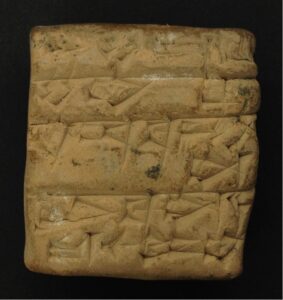
It’s small: a bit over an inch high, not quite that wide, and only half an inch thick at its thickest point. It’s the color of sand. But it has survived for four millennia and carries a lot of information for its size.
The cuneiform tablet recently acquired by the Libraries’ Rare Books Program dates from the reign of King Shulgi of Ur (21st century BCE). It records the receipt of “2 royal kor of flour” in the city of Drehem, a major tax collection point during the third Ur Dynasty. Many thousands of tablets like this one have been excavated at that location.
The tablet is now the oldest object in the rare book collections, having easily edged out the item that formerly held that distinction, a Book of Hours from 1420.
The two objects are a study in contrasts: our Book of Hours is a thing of rare beauty, glittering with gold, decorated with brilliant colors, and expressly designed to inspire awe and reverence. The cuneiform tablet, on the other hand, is physically drab, monochromatic, and created to record a mundane transaction. But for students in various classes this fall who had the opportunity to work with these objects, deciding which of the two was more compelling was not an easy choice.


